

How the Flipped Classroom Is Radically Transforming Learning. Editor's Note:Posts about the flipped class on The Daily Riff beginning in January 2011 have generated over 240,000 views to-date - thanks contributors and readers . . .

See our other links related to the flipped class below this guest post. Since this post was written, Bergmann and Sams have released their book, Flip your Classroom: Reach Every Student in Every Class Every Day. Do check it out. - C.J. Westerberg How the Flipped Classroom was Born. The Flipped Classroom: Pro and Con. In 2012, I attended the ISTE conference in San Diego, CA.
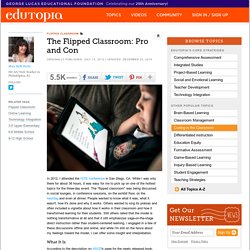
While I was only there for about 36 hours, it was easy for me to pick up on one of the hottest topics for the three-day event. The "flipped classroom" was being discussed in social lounges, in conference sessions, on the exhibit floor, on the hashtag and even at dinner. People wanted to know what it was, what it wasn't, how it's done and why it works. Others wanted to sing its praises and often included a vignette about how it works in their classroom and how it transformed learning for their students. Still others railed that the model is nothing transformative at all and that it still emphasizes sage-on-the-stage direct instruction rather than student-centered learning. 7 Essential Tools for a Flipped Classroom - Getting Smart by Guest Author - classrooms, EdTech, flipped classroom.
By: Erin Palmer The flipped classroom uses technology to allow students more time to apply knowledge and teachers more time for hands-on education.
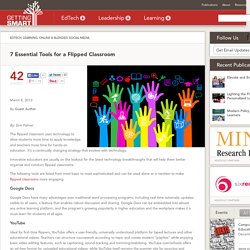
It’s a continually changing strategy that evolves with technology. 16 Flipped Classrooms In Action Right Now. Flipped classrooms require educators to reconstruct traditional classrooms by sending lectures home and providing more face-to-face time at school, but elementary- through university-level instructors are finding good reasons to try them out. Frequently traced back to Colorado teachers Aaron Sams and JonathanBergmann, who were quick to experiment with posting videos online in 2008, the flipped classroom concept is small, simple and has shown positive results. The general idea is that students work at their own pace, receiving lectures at home via online video or podcasts and then devoting class time to more in-depth discussion and traditional “homework.”
Where: Clear Brook High School, Harris County, Texas At the beginning of the school year, geometry teacher Leticia Allred told her Pre-AP Geometry class at Texas’ Clear Brook High School that their only homework would be watching 15-minute YouTube videos and taking notes. Where: Wausau West High School, Wasau, Wis. The Flipped Classroom Guide for Teachers. As technology becomes increasingly common in instruction at all levels of education from kindergarten to college, the modern classroom is changing.
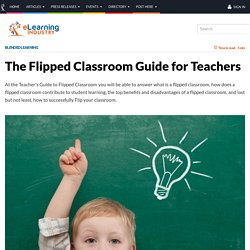
The traditional teacher-centered classroom is falling away to give students a student-centered classroom where collaborative learning is stressed. One way educators are effectively utilizing online learning and changing the way they teach is by flipping their classrooms. What is a Flipped Classroom? Flipped Classroom - Unlimited Personalized Lessons from Knewton. Flipped classroom. A flipped classroom is an instructional strategy and a type of blended learning that reverses the traditional learning environment by delivering instructional content, often online, outside of the classroom.
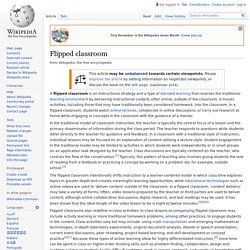
It moves activities, including those that may have traditionally been considered homework, into the classroom. In a flipped classroom, students watch online lectures, collaborate in online discussions, or carry out research at home while engaging in concepts in the classroom with the guidance of a mentor. In the traditional model of classroom instruction, the teacher is typically the central focus of a lesson and the primary disseminator of information during the class period.
The teacher responds to questions while students defer directly to the teacher for guidance and feedback. In a classroom with a traditional style of instruction, individual lessons may be focused on an explanation of content utilizing a lecture-style. The Teacher's Guide To Flipped Classrooms. Since Jonathan Bergman and Aaron Sams first experimented with the idea in their Colorado classrooms in 2004, flipped learning has exploded onto the larger educational scene.
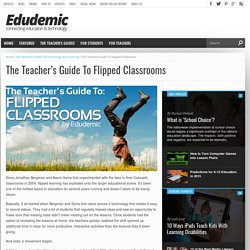
It’s been one of the hottest topics in education for several years running and doesn’t seem to be losing steam. Basically, it all started when Bergman and Sams first came across a technology that makes it easy to record videos. They had a lot of students that regularly missed class and saw an opportunity to make sure that missing class didn’t mean missing out on the lessons. 5 Best Practices for the Flipped Classroom. Ok, I'll be honest.

I get very nervous when I hear education reformists and politicians tout how "incredible" the flipped-classroom model, or how it will "solve" many of the problems of education. It doesn't solve anything. Flipping the Classroom. “Flipping the classroom” has become something of a buzzword in the last several years, driven in part by high profile publications in The New York Times (Fitzpatrick, 2012); The Chronicle of Higher Education (Berrett, 2012); and Science (Mazur, 2009); In essence, “flipping the classroom” means that students gain first exposure to new material outside of class, usually via reading or lecture videos, and then use class time to do the harder work of assimilating that knowledge, perhaps through problem-solving, discussion, or debates.

In terms of Bloom’s revised taxonomy (2001), this means that students are doing the lower levels of cognitive work (gaining knowledge and comprehension) outside of class, and focusing on the higher forms of cognitive work (application, analysis, synthesis, and/or evaluation) in class, where they have the support of their peers and instructor. What is it? | Does it work? | Theoretical basis | Key Elements | Where can I learn more? | References.